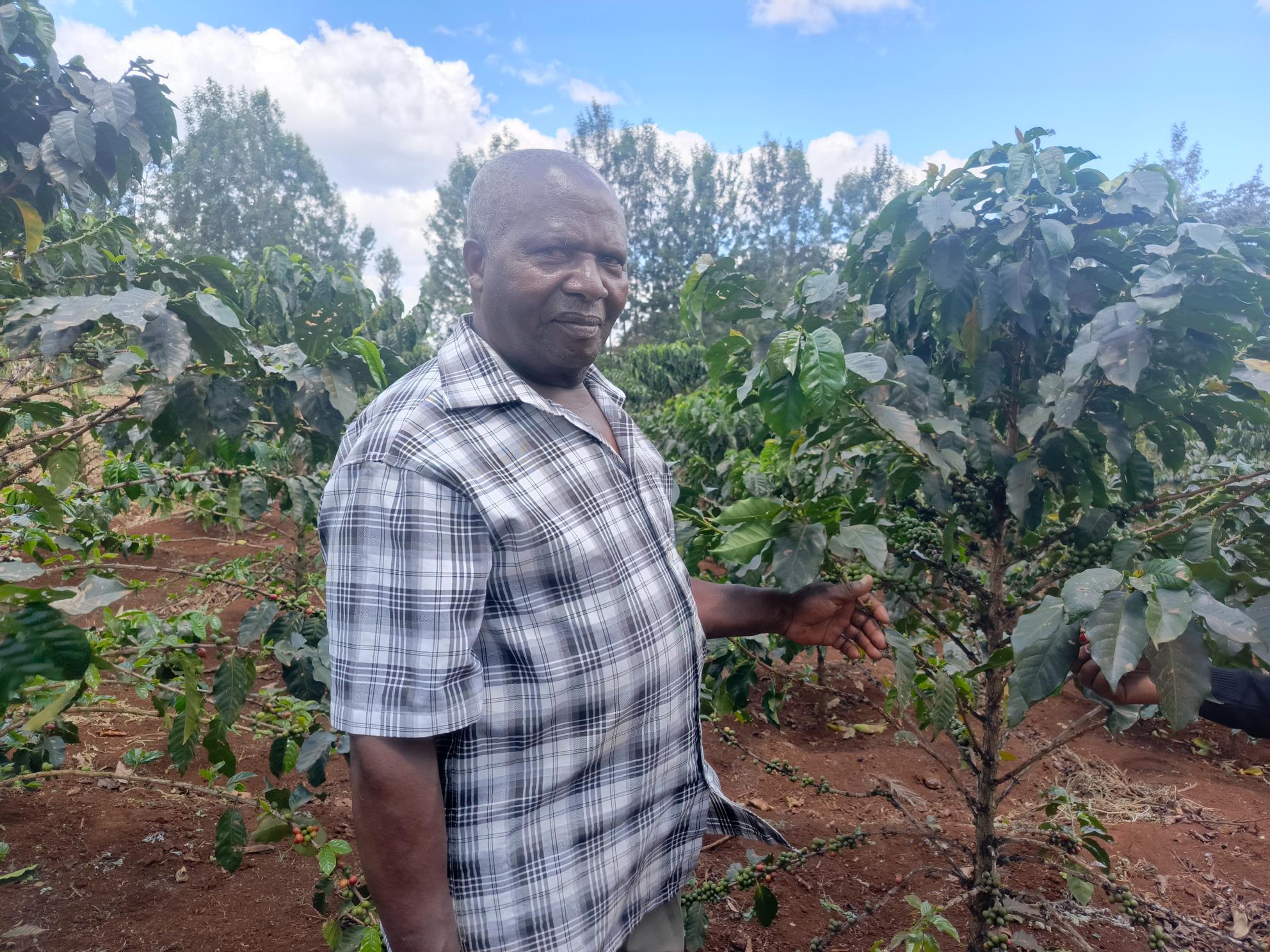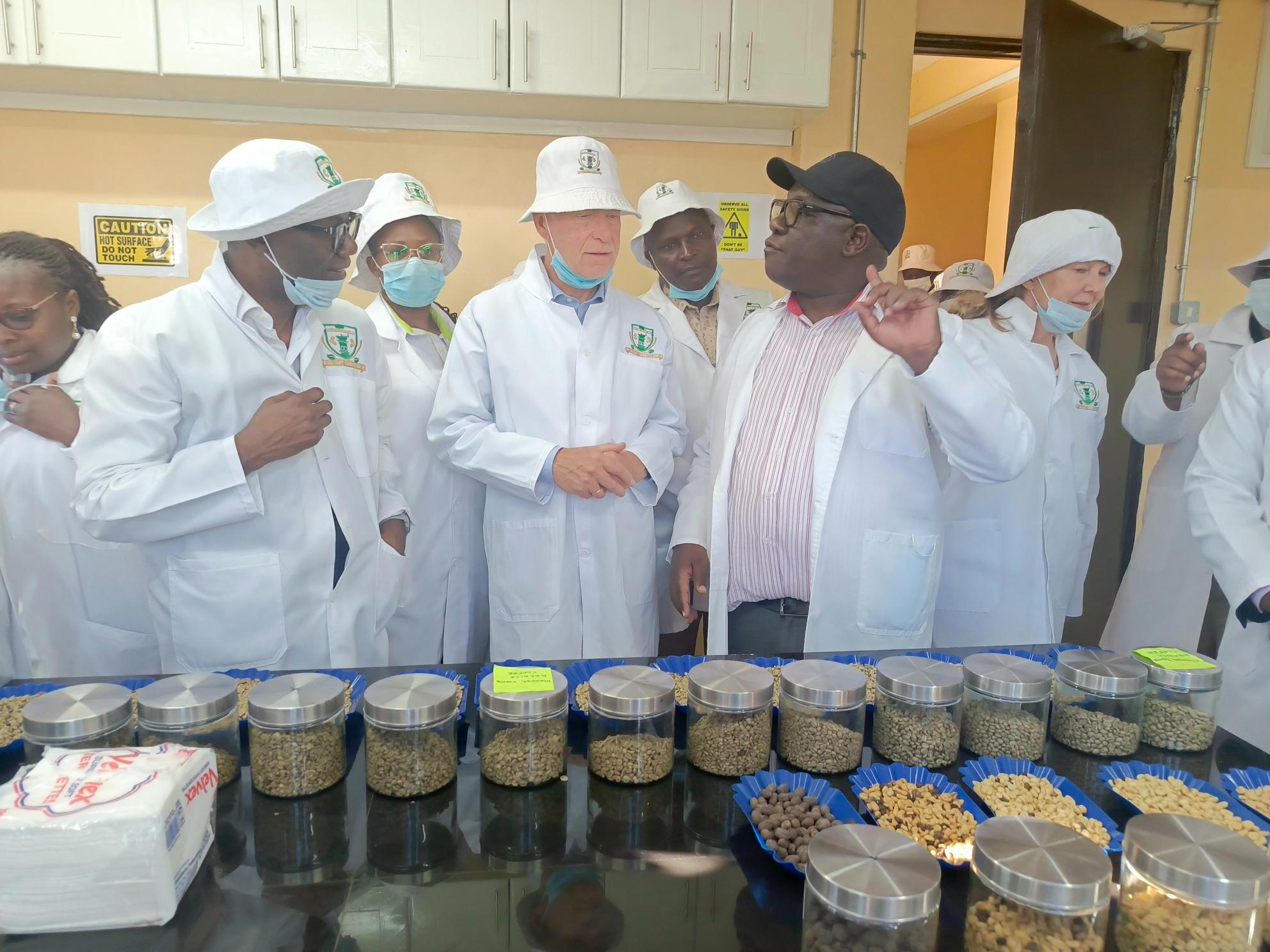
Fintech firm opens door for Kenyans to trade U.S stocks
The firm advised users to approach trading with caution
Kenya Integrated Agricultural Management Information System is helping unify data and digitalise agricultural services.
In Summary

Audio By Vocalize
 Geoffrey Kibui, a coffee farmer from Kirinyaga county/AGATHA NGOTHO
Geoffrey Kibui, a coffee farmer from Kirinyaga county/AGATHA NGOTHO  FAO Kenya office representative Dr Charles Bebay (2nd left), Swedish
Ambassador to Kenya Håkan Åkesson and Kirinyaga county cooperative union mill manager Patrick Kahonge during the facility /AGATHA NGOTHO
FAO Kenya office representative Dr Charles Bebay (2nd left), Swedish
Ambassador to Kenya Håkan Åkesson and Kirinyaga county cooperative union mill manager Patrick Kahonge during the facility /AGATHA NGOTHO On
a cool morning in Runyenjes, Kirinyaga county, farmer Geoffrey Kibui
pauses under the shade of his coffee trees to check his phone.
A simple SMS has just landed – a fertiliser voucher from the government’s new e-voucher system.
For Kibui, it is more than just a message; it is proof of a revolution that has begun to reshape the lives of coffee farmers across the county.
“Before, accessing fertiliser was a challenge and, when available, it was costly,” the farmer recalls. “These days it is cheaper and thanks to this, production has gone up. We are very grateful.”
Kibui is one of thousands of smallholder farmers now benefiting from digital tools, subsidies and a new farmer-owned coffee mill that are not only boosting yields but also incomes.
Digital shift
The backbone of this transformation is the Kenya Integrated Agricultural Management Information System (Kiamis), conceived in 2018 by the government and the Food and Agriculture Organization.
The system unifies farmer data and digitalises agricultural services. After a pilot in Uasin Gishu and Nyandarua between 2019 and 2020, Kiamis was scaled nationwide with support from the Embassy of Sweden, which invested Sh750 million.
Today, more than 6.5 million farmers are registered.
In Kirinyaga alone, 135,000 farmers have signed up in the past year and a half. With the e-voucher system, they can now access subsidised fertilisers directly, cutting out costly middlemen.
“The
e-voucher programme has made services more efficient,” John Gachara,
Kirinyaga’s agriculture executive, says. “We are now looking at integrating
county and national systems so farmers can query directly through mobile apps
and connect with extension officers.”
For
Kibui and others, the benefits are clear. Fertiliser costs have fallen from
Sh7,000 to Sh2,500, while better access to inputs is lifting yields across
coffee, maize and even livestock feed.
Owning the value chain
At the heart of Kirinyaga’s coffee renaissance is the Kirinyaga coffee mill, a facility owned entirely by local farmers through their county cooperative union. Opened less than two years ago, the mill has already become a cornerstone of Kenya’s coffee sector.
“Kirinyaga produces about 25 per cent of the country’s coffee,” mill manager Patrick Kahonge explains. “Today, 90 to 99 per cent of that coffee goes through this mill. We’ve expanded our milling capacity from two tonnes per hour to two tonnes, enough to handle up to 60 percent of Kenya’s production.”
By owning the mill, farmers now capture more value from their beans and retain greater control of the supply chain.
The stakes are high. With the European Union buying more than half of Kenya’s coffee compliance with new deforestation and traceability rules has become critical. Digital registration, Kahonge says, is the only way to meet the December 31 deadline.
“If we lose 25 per cent of our market, the ripple effect will be huge,” he warns. “That’s why we are working with FAO and the government to complete data uploads on time.”
Partners in transformation
Sweden has been one of the strongest backers of Kenya’s digital agriculture shift. Ambassador Håkan Åkesson, who recently toured farms in Kirinyaga, says the real win is not just in the millions invested but in building sustainable systems.
“This is not just about money, it’s about smart solutions,” he said. “With digitalisation, all farmers in Kenya will be able to access platforms to get fertilisers at the right price and receive the right information at the right time. This is the beginning of a very exciting journey.”
FAO’s project specialist, Wilfred Oluoch, agrees. He says registration not only delivers subsidies but also ensures accountability and compliance with global rules.
“The main purpose is to know who our farmers are and reach them with the benefits due to them,” Oluoch says. “Through registration, farmers can access the National Fertiliser Subsidy Programme, which reduces costs by up to 40 per cent. This has already boosted harvests, household incomes, and local economies.”
Model for resilience
Back on his farm, Kibui admits there are still hurdles – pests like leaf worms remain a constant threat. Yet he insists the digital systems, and new cooperative structures have made farming less uncertain.
“The system is easy,” he says. “When I receive the message, I just go to the system. Before, we had to buy fertilisers from shops at very high prices. Things have really changed.”
For Kirinyaga, the blend of technology, farmer ownership and global partnerships may be more than just a success story. It could become a blueprint for resilience — one that secures the future of Kenyan coffee while inspiring similar transformations across agriculture.
“What began as a struggle with costly inputs is now evolving into a model of accountability and growth,” Åkesson says. “This is how we safeguard Kenya’s coffee industry – by putting farmers and smart systems at the centre.”

The firm advised users to approach trading with caution